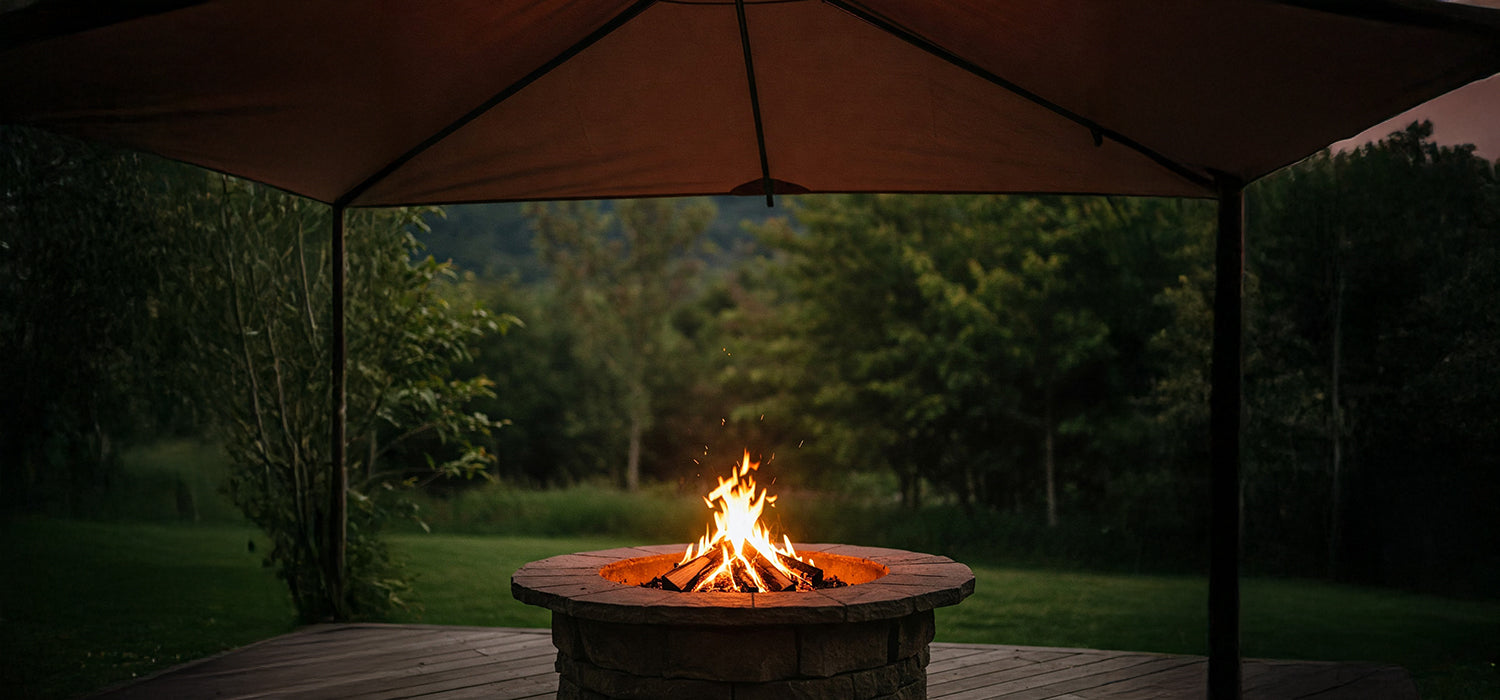
The Ultimate Guide to Fire Pits Under Awnings: Safety, Design, and More
Dreaming of a cosy evening under the stars without braving the British weather? A fire pit under an awning might be your answer! Whether you love the crackle of wood or the convenience of fire tables, we’ve got tips to keep your outdoor space safe, stylish, and year-round-ready. Keep reading to find out how!
Awning Material and Combustibility
Fabric and Synthetic Materials:
Potential for Melting or Catching Fire
When it comes to fire pits under an awning, the material above you matters. While fabric and synthetic materials can look great, they come with a risk. These materials are often highly flammable and can melt or catch fire if exposed to high heat. For example, a canvas awning that looks fabulous in your garden could quickly become a danger if the fire pit gets a little too hot. So, while it’s tempting to choose these affordable and attractive options, fire safety should be your priority.
Importance of Fire-Resistant Materials
If you do choose a fabric awning, make sure it’s been treated with a fire-resistant coating. These types of fabrics are specifically designed to withstand heat, which gives you peace of mind while enjoying your fire pit. In fact, investing in fire-resistant materials not only keeps your outdoor space safer, but it also extends the life of your awning, so you’ll save money in the long run.
Metal or Rigid Awnings:
Heat Transfer and Potential for Damage
Metal or rigid awnings, such as those made from steel or aluminium, are a much safer choice for covering a fire pit. However, it’s important to remember that they’re not completely risk-free. The metal can absorb heat from the flames and transfer it to the structure of the awning. Over time, this could cause wear and tear, particularly if your fire pit is used frequently. So, while metal awnings are a great option, you’ll need to take precautions to protect them from the high temperatures they’re exposed to.
Clearance and Safety Distances
Distance from Awning:
Maintaining a Safe Distance from the Flames and Heat
When installing a fire pit under an awning, clearance is non-negotiable. Experts agree that keeping at least 3 feet between the fire pit and any overhead structure is crucial. This distance prevents heat from building up beneath your awning, reducing the risk of damage or fire. Imagine enjoying the warmth of your fire pit, only to realise that the heat has cracked your beautiful awning – not fun!
This simple step helps ensure your setup remains safe while allowing you to sit back, relax, and enjoy your outdoor space.
Airflow and Ventilation:
Ensuring Adequate Ventilation to Prevent Heat Buildup
Next up: ventilation. Adequate airflow is key in any fire pit setup. Without it, you’re just asking for trouble. Heat can quickly build up underneath the awning, raising the risk of fire or creating a sauna-like environment in your outdoor area. Look for awning designs that feature open sides or adjustable vents to allow fresh air to circulate freely. This doesn’t just keep the temperature comfortable; it’s also vital for reducing the risk of smoke and heat accumulation.
Fire Pit Design and Features
Low-Profile Fire Pits:
Reduced Heat Transfer to the Awning
If you’re keen on having a fire pit under your awning, consider opting for a low-profile design. These fire pits sit closer to the ground, which means less heat rises towards the awning. By choosing a low-profile model, you’ll keep the heat where it belongs – on you and your guests, not your roof! Plus, these fire pits often have a more modern, stylish look, which can elevate the aesthetic of your outdoor space.
Built-in Safety Features:
Flame Height Adjustment and Safety Shut-Off
The latest fire pits come with some fantastic safety features. Look for models with flame height adjustment, which allows you to control the intensity of the fire. This is particularly useful for keeping the flames under control when you’re under an awning. Some fire pits also include a safety shut-off feature, which automatically turns the flames off if there’s a malfunction or if the fire gets too high. These built-in features add an extra layer of protection, giving you peace of mind while you relax by the fire.
Alternatives and Precautions
Open-Air Areas:
Safer Option with Better Ventilation
If you’re still concerned about fire safety under an awning, consider moving your fire pit to an open-air area. Open spaces offer better ventilation and less risk of heat accumulation. In an open area, you won’t have to worry as much about heat transfer to nearby structures, and the smoke can dissipate more easily. Plus, you’ll be able to enjoy the stars without worrying about the fire affecting your awning or other outdoor features.
Fire-Resistant Awning Materials:
Choosing Materials That Can Withstand Heat
If you’re set on keeping your fire pit under an awning, opt for fire-resistant materials. These awnings are made to withstand the heat from your fire pit without catching fire or melting. A good option could be a metal-framed awning with heat-resistant fabric. These materials are specifically designed for high-heat environments, so they’re perfect for your fire pit setup. When choosing your awning, make sure it’s rated for fire resistance, and don’t hesitate to ask an expert if you’re unsure about the best choice for your space.
Conclusion
Setting up a fire pit under an awning can transform your outdoor area into a warm and inviting space, perfect for year-round enjoyment. But safety should always be your top priority. By following the tips outlined in this guide – from choosing the right materials to ensuring proper clearance and ventilation – you can enjoy the perfect balance of style and safety. Whether you're sipping a drink with friends or warming up on a chilly evening, your fire pit will be a highlight of your outdoor space, without the worry.
Other content we think you'll love
- Is it Safe to Put a Fire Table on Wooden Decking?
- Is It Safe to Put a Fire Table on Composite Decking?
- Can Fire Tables Be Placed on Grass?
- Can You Put a Fire Pit on Fake Grass?
- Will Fire Pit Kill Grass?
- Can You Use a Gas Fire Table Under a Covered Patio?
- Can You Put a Gas Fire Pit Under a Pergola?
- Can You Put a Gas Fire Pit Under a Gazebo?
- Can You Put a Gas Fire Pit on a Deck?
- Can You Put a Gas Fire Pit in a Wood Table?
- Is a Gas Fire Pit Considered an Open Fire?
- Can I Have a Fire Pit on My Balcony?
- Fire Pit Under Polycarbonate Roof: Everything You Need to Know

